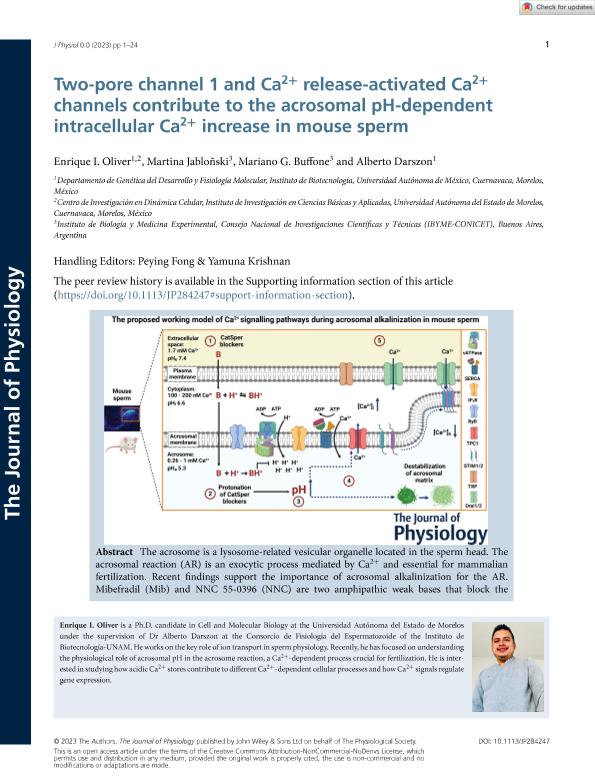Mostrar el registro sencillo del ítem
dc.contributor.author
Oliver, Enrique I.
dc.contributor.author
Jabloñski, Martina

dc.contributor.author
Buffone, Mariano Gabriel

dc.contributor.author
Darszon, Alberto
dc.date.available
2024-04-22T10:38:52Z
dc.date.issued
2023
dc.identifier.citation
Oliver, Enrique I.; Jabloñski, Martina; Buffone, Mariano Gabriel; Darszon, Alberto; Two-pore channel 1 and Ca2+ release-activated Ca2+ channels contribute to the acrosomal pH-dependent intracellular Ca2+ increase in mouse sperm; John Wiley and Sons Inc; Journal of Physiology; 601; 14; 2023; 1-24
dc.identifier.issn
0022-3751
dc.identifier.uri
http://hdl.handle.net/11336/233649
dc.description.abstract
The acrosome is a lysosome-related vesicular organelle located in the sperm head. The acrosomal reaction (AR) is an exocytic process mediated by Ca2+ and essential for mammalian fertilization. Recent findings support the importance of acrosomal alkalinization for the AR. Mibefradil (Mib) and NNC 55-0396 (NNC) are two amphipathic weak bases that block the sperm-specific Ca2+ channel (CatSper) and induce acrosomal pH (pHa ) increase by accumulating in the acrosomal lumen of mammalian sperm. This accumulation and pHa elevation increase the intracellular Ca2+ concentration ([Ca2+ ]i ) and trigger the AR by unknown mechanisms of Ca2+ transport. Here, we investigated the pathways associated with the pHa increase-induced Ca2+ signals using mouse sperm as a model. To address these questions, we used single-cell Ca2+ imaging, the lysosomotropic agent Gly-Phe-β-naphthylamide (GPN) and pharmacological tools. Our findings show that Mib and NNC increase pHa and release acrosomal Ca2+ without compromising acrosomal membrane integrity. Our GPN results indicate that the osmotic component does not significantly contribute to acrosomal Ca2+ release caused by pHa rise. Inhibition of two-pore channel 1 (TPC1) channels reduced the [Ca2+ ]i increase stimulated by acrosomal alkalinization. In addition, blockage of Ca2+ release-activated Ca2+ (CRAC) channels diminished Ca2+ uptake triggered by pHa alkalinization. Finally, our findings contribute to understanding how pHa controls acrosomal Ca2+ efflux and extracellular Ca2+ entry during AR in mouse sperm. KEY POINTS: The acrosomal vesicle is a lysosome-related organelle located in the sperm head. The acrosome reaction (AR) is a highly regulated exocytic process mediated by Ca2+ , which is essential for fertilization. However, the molecular identity of Ca2+ transporters involved in the AR and their mechanisms to regulate Ca2+ fluxes are not fully understood. In mammalian sperm, acrosomal alkalinization induces intracellular Ca2+ concentration ([Ca2+ ]i ) increase and triggers the AR by unknown molecular mechanisms of Ca2+ transport. In this study, we explored the molecular mechanisms underlying Ca2+ signals caused by acrosomal alkalinization using mouse sperm as a model. TPC1 and CRAC channels contribute to [Ca2+ ]i elevation during acrosomal alkalinization. Our findings expand our understanding of how the acrosomal pH participates in the physiological induction of the AR.
dc.format
application/pdf
dc.language.iso
eng
dc.publisher
John Wiley and Sons Inc

dc.rights
info:eu-repo/semantics/openAccess
dc.rights.uri
https://creativecommons.org/licenses/by-nc-nd/2.5/ar/
dc.subject
CRAC CHANNELS
dc.subject
Ca2+ SIGNALS
dc.subject
sTPC1 CHANNEL
dc.subject
ACROSOMAL ALKALINIZATION
dc.subject
ACROSOMAL REACTION
dc.subject
ACROSOMAL VEHICLE
dc.subject.classification
Biología Reproductiva

dc.subject.classification
Ciencias Biológicas

dc.subject.classification
CIENCIAS NATURALES Y EXACTAS

dc.title
Two-pore channel 1 and Ca2+ release-activated Ca2+ channels contribute to the acrosomal pH-dependent intracellular Ca2+ increase in mouse sperm
dc.type
info:eu-repo/semantics/article
dc.type
info:ar-repo/semantics/artículo
dc.type
info:eu-repo/semantics/publishedVersion
dc.date.updated
2024-02-22T12:58:52Z
dc.identifier.eissn
1469-7793
dc.journal.volume
601
dc.journal.number
14
dc.journal.pagination
1-24
dc.journal.pais
Reino Unido

dc.journal.ciudad
Londres
dc.description.fil
Fil: Oliver, Enrique I.. Universidad Nacional Autónoma de México; México
dc.description.fil
Fil: Jabloñski, Martina. Consejo Nacional de Investigaciones Científicas y Técnicas. Instituto de Biología y Medicina Experimental. Fundación de Instituto de Biología y Medicina Experimental. Instituto de Biología y Medicina Experimental; Argentina
dc.description.fil
Fil: Buffone, Mariano Gabriel. Consejo Nacional de Investigaciones Científicas y Técnicas. Instituto de Biología y Medicina Experimental. Fundación de Instituto de Biología y Medicina Experimental. Instituto de Biología y Medicina Experimental; Argentina
dc.description.fil
Fil: Darszon, Alberto. Universidad Nacional Autónoma de México; México
dc.journal.title
Journal of Physiology
dc.relation.alternativeid
info:eu-repo/semantics/altIdentifier/url/https://physoc.onlinelibrary.wiley.com/doi/10.1113/JP284247
dc.relation.alternativeid
info:eu-repo/semantics/altIdentifier/doi/http://dx.doi.org/10.1113/JP284247
Archivos asociados
